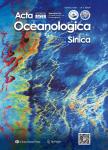El Ni?o/Southern Oscillation during the 4.2 ka event recorded by growth rates of corals from the North South China Sea
El Ni?o/Southern Oscillation during the 4.2 ka event recorded by growth rates of corals from the North South China Sea作者机构:Guangxi Laboratory on the Study of Coral Reefs in the South China SeaGuangxi UniversityNanning 530004China Coral Reef Research Center of ChinaGuangxi UniversityNanning 530004China School of Marine SciencesGuangxi UniversityNanning 530004China South China Sea Institute of OceanologyChinese Academy of SciencesGuangzhou 510301China College of Ocean EngineeringGuangdong Ocean UniversityZhanjiang 524088China
出 版 物:《Acta Oceanologica Sinica》 (海洋学报(英文版))
年 卷 期:2020年第39卷第1期
页 面:110-117页
核心收录:
学科分类:0710[理学-生物学] 07[理学] 0908[农学-水产] 070601[理学-气象学] 0707[理学-海洋科学] 0706[理学-大气科学] 071004[理学-水生生物学]
基 金:The National Natural Science Foundation of China under contract No.91428203 the Guangxi Scientific Projects under contract Nos AD17129063 and AA17204074 the Bagui Fellowship from Guangxi of China
主 题:4.2 ka event ENSO variability SSTA coral growth rate Xisha Islands
摘 要:The 4.2 ka event that occurred during the period from 4 500–3 900 a BP was characterized by cold and dry climates and resulted in the collapse of civilizations around the world. The cause of this climatic event, however, has been under debate. We collected four corals(Porites lutea) from Yongxing Island, Xisha Islands, South China Sea, dated them with the U-series method, and measured the annual coral growth rates using X-ray technology. The dating results showed that the coral growth ages were from 4 500–3 900 a BP, which coincide well with the period of the4.2 ka event. We then reconstructed annual sea surface temperature anomaly(SSTA) variations based on the coral growth rates. The growth rate-based SSTA results showed that the interdecadal SSTA from 4 500–3 900 a BP was lower than that during modern times(1961–2008 AD). A spectral analysis showed that the SSTA variations from4 500–3 900 a BP were under the influence of El Nino-Southern Oscillation(ENSO) activities. From 4 500–4 100 a BP, the climate exhibited La Nina-like conditions with weak ENSO intensity and relatively stable and lower SSTA amplitudes. From 4 100–3 900 a BP, the climate underwent a complicated period of ENSO variability and showed alternating El Nino-or La Nina-like conditions at interdecadal time scales and large SSTA amplitudes. We speculate that during the early and middle stages of the 4.2 ka event, the cold climate caused by weak ENSO activities largely weakened social productivity. Then, during the end stages of the 4.2 ka event, the repeated fluctuations in the ENSO intensity caused frequent extreme weather events, resulting in the collapse of civilizations worldwide. Thus, the new evidence obtained from our coral records suggests that the 4.2 ka event as well as the related collapse of civilizations were very likely driven by ENSO variability.



